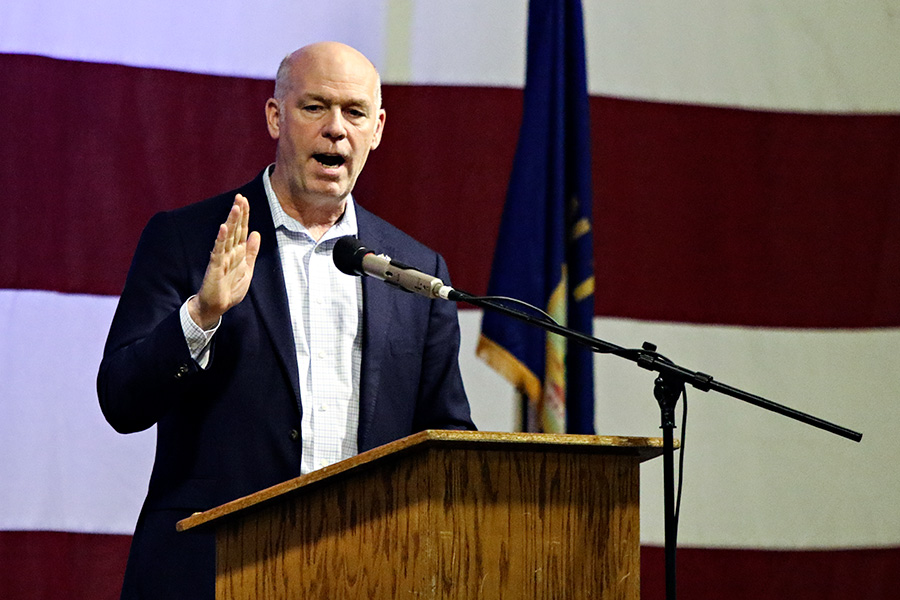Gianforte Signs Bill Allowing Governors to Appoint Judges to Vacant Seats
Senate Bill 140 eliminates the decades-old independent Judicial Nomination Commission
By Mara Silvers, Montana Free Press
HELENA — Gov. Greg Gianforte on Tuesday announced he has signed a controversial bill allowing Montana’s governor to directly appoint judges to fill temporary vacancies in district courts and the state Supreme Court, a marked change from the less partisan, independent process Montanans created after the 1972 Constitutional Convention.
In signing Senate Bill 140, carried by Sen. Keith Regier, R-Whitefish, Gianforte is allowing himself and future governors to handpick judges to temporarily sit in highly influential roles, though they would still be subject to the will of the voters in the next consecutive election following their appointment.
“When judicial vacancies occur, I will appoint well-qualified judges who will protect and uphold the Constitution and who will interpret laws, not make them from the bench,” Gianforte said in a Tuesday evening press release announcing the bill signing earlier that day. “I am committed to appointing judges transparently, providing for robust public input, and ensuring judges have a diversity of legal background and subject matter expertise.”
The bill received extensive debate in the Senate and the House. Proponents of the current Judicial Nomination Commission stressed the independent nature of the seven-person body, which deliberates publicly about interim appointment candidates before sending a selection of nominees to the governor’s desk, as well as the importance of that separation of powers.
People who spoke in favor of SB 140, including Lt. Gov. Kristen Juras, dismissed characterizations of the Judicial Nomination Commission as nonpartisan. Four of its members are lay people appointed by the sitting governor, while three are legal professionals selected by district and Supreme Court judges.
“Let’s get rid of the fiction that this is somehow a nonpartisan process,” Juras said in February testimony before the Senate Judiciary Committee. “It is not.”
Juras described Gianforte’s interest in the bill as part of a desire to consider all candidates who are interested in filling a vacancy, rather than selecting an applicant from a list narrowed by the Judicial Nominating Commission. In announcing Gianforte’s signing of the bill, spokeswoman Brooke Stroyke said the new law appropriately removes the “middleman” from the process while still allowing for “transparency and public input by requiring the governor to publicly announce a vacancy and requiring at least 30 days for public comment on applicants.”
The new law requires that gubernatorial appointees be confirmed by the Senate, as is currently the case. That process is under scrutiny as three district court judges who are filling vacancies that arose under the Bullock administration have not yet been confirmed by the Senate. Regier, who serves as the chair of the Senate Judiciary Committee, previously told Lee newspapers that he had held off on scheduling hearings for the judges currently filling positions in Lewis and Clark, Gallatin and Cascade Counties until the governor decided whether to sign SB 140.
As the bill advanced through both chambers, critics said it would dangerously undermine the deliberative process for filling judicial vacancies by removing the stage in which applicants are vetted by their peers and members of the public.
An op-ed written by two former state legislators and former Republican Gov. Marc Racicot described the current process as one that “provides the most assurance possible that those candidates most qualified by reason of judicial temperament, diligence and ethical conduct will be appointed by the governor to judicial office.” Under SB 140, they wrote, the governor could select “any lawyer with zero regard for his or her qualifications, experience, integrity, record or judicial disposition.”
In the press release issued Tuesday, Stroyke wrote that the continued requirement of Senate confirmation and the temporary nature of the appointments maintain “two substantial checks on the governor’s authority.”
The law is effective immediately.
This story originally appeared in Montana Free Press, which can be found online at montanafreepress.org.